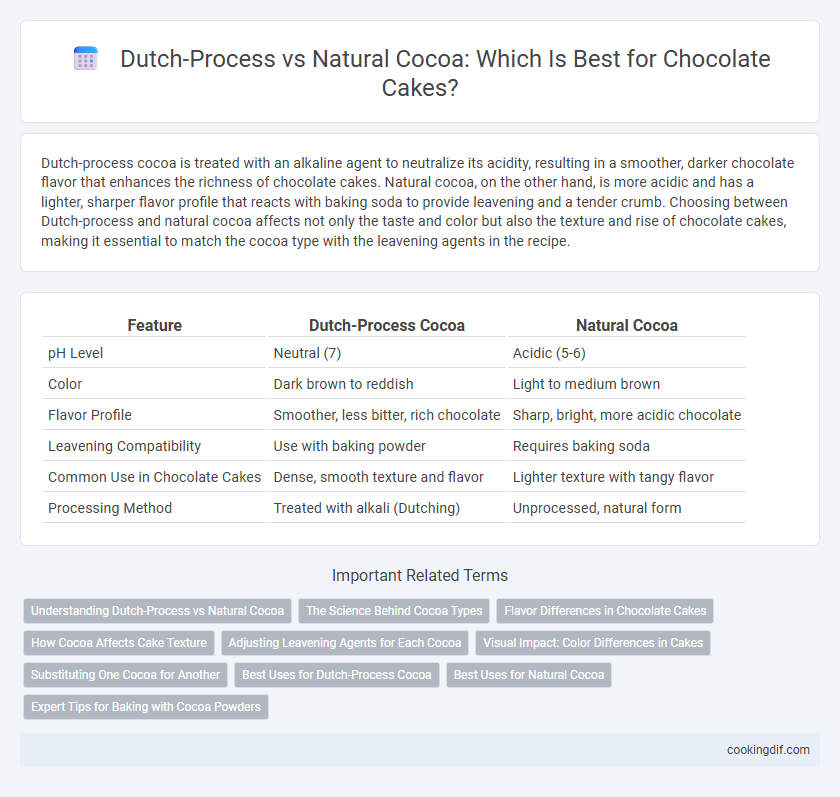Dutch-process cocoa is treated with an alkaline agent to neutralize its acidity, resulting in a smoother, darker chocolate flavor that enhances the richness of chocolate cakes. Natural cocoa, on the other hand, is more acidic and has a lighter, sharper flavor profile that reacts with baking soda to provide leavening and a tender crumb. Choosing between Dutch-process and natural cocoa affects not only the taste and color but also the texture and rise of chocolate cakes, making it essential to match the cocoa type with the leavening agents in the recipe.
Table of Comparison
| Feature | Dutch-Process Cocoa | Natural Cocoa |
|---|---|---|
| pH Level | Neutral (7) | Acidic (5-6) |
| Color | Dark brown to reddish | Light to medium brown |
| Flavor Profile | Smoother, less bitter, rich chocolate | Sharp, bright, more acidic chocolate |
| Leavening Compatibility | Use with baking powder | Requires baking soda |
| Common Use in Chocolate Cakes | Dense, smooth texture and flavor | Lighter texture with tangy flavor |
| Processing Method | Treated with alkali (Dutching) | Unprocessed, natural form |
Understanding Dutch-Process vs Natural Cocoa
Dutch-process cocoa undergoes an alkalizing treatment that reduces acidity and enhances its dark color, resulting in a smoother and less bitter flavor compared to natural cocoa. Natural cocoa is more acidic and lighter in color, providing a sharper, more intense chocolate taste that reacts with baking soda to help leaven cakes. Understanding the differences between Dutch-process and natural cocoa is crucial for selecting the right ingredient to achieve desired texture, taste, and rise in chocolate cake recipes.
The Science Behind Cocoa Types
Dutch-process cocoa undergoes alkalization, which neutralizes its acidity and results in a darker color and smoother, milder flavor ideal for rich chocolate cakes. Natural cocoa retains its acidic nature, reacts with baking soda to create lift and a tangy taste that enhances traditional chocolate cake recipes. Understanding the pH differences between Dutch-process (neutral pH) and natural cocoa (pH 5-6) is crucial for optimizing leavening and flavor development in chocolate cake baking.
Flavor Differences in Chocolate Cakes
Dutch-process cocoa offers a smoother, milder flavor with reduced acidity, resulting in a richer and more mellow chocolate taste in cakes. Natural cocoa has a more intense, robust chocolate flavor with higher acidity that can enhance leavening reactions, producing a slightly tangy and sharper chocolate profile in baked goods. The choice between Dutch-process and natural cocoa significantly impacts the depth and brightness of chocolate flavor in cakes, influencing both taste and texture.
How Cocoa Affects Cake Texture
Dutch-process cocoa has a neutral pH, which results in a smoother, finer crumb and a darker color in chocolate cakes, enhancing moisture retention and tenderness. Natural cocoa is acidic and reacts with baking soda, creating a lighter, coarser texture with a somewhat tangy flavor. The choice between Dutch-process and natural cocoa directly influences the cake's rise, crumb structure, and overall mouthfeel due to differences in acidity and alkalinity.
Adjusting Leavening Agents for Each Cocoa
Dutch-process cocoa is alkalized, neutralizing acidity and resulting in a milder flavor that requires baking powder as a leavening agent for proper rise in chocolate cakes. Natural cocoa retains its natural acidity and reacts with baking soda, producing carbon dioxide that helps the cake rise and develop a tender crumb. Adjusting leavening agents by using baking powder with Dutch-process cocoa and baking soda with natural cocoa ensures optimal texture and flavor in chocolate cakes.
Visual Impact: Color Differences in Cakes
Dutch-process cocoa produces a chocolate cake with a darker, richer brown color due to its alkalized treatment, enhancing visual appeal and depth. Natural cocoa yields a lighter, reddish-brown crumb, offering a more rustic look often prized in traditional recipes. The color distinction between these two cocoa types directly affects the presentation and perceived flavor intensity of chocolate cakes.
Substituting One Cocoa for Another
Dutch-process cocoa has a neutral pH of about 7, making it less acidic than natural cocoa, which typically has a pH around 5 to 6. When substituting Dutch-process for natural cocoa in chocolate cake recipes, it's important to adjust leavening agents, using baking powder instead of baking soda, to ensure proper rising and texture. The choice between Dutch-process and natural cocoa significantly impacts the cake's flavor profile and crumb structure due to their differing acidity levels.
Best Uses for Dutch-Process Cocoa
Dutch-process cocoa is best for chocolate cakes requiring a smooth, mellow flavor and a darker color, as its alkalized treatment neutralizes acidity and enhances cocoa solubility. It excels in recipes with baking powder rather than baking soda, since its neutral pH does not activate alkaline leavening agents. Dutch-process cocoa creates moist, tender cakes with rich chocolate taste, ideal for dense or layered chocolate desserts.
Best Uses for Natural Cocoa
Natural cocoa, with its light color and tangy, acidic flavor, is best suited for recipes that use baking soda as a leavening agent, such as traditional chocolate cakes and brownies. Its acidity reacts with baking soda to create a tender crumb and enhanced rise, resulting in moist and fluffy baked goods. Natural cocoa is ideal for recipes requiring a bright chocolate taste and lighter color in the finished cake.
Expert Tips for Baking with Cocoa Powders
Dutch-process cocoa has been alkalized to neutralize acidity, providing a smoother, milder chocolate flavor and darker color, making it ideal for recipes using baking powder. Natural cocoa is more acidic and imparts a sharper, deeper chocolate taste that reacts with baking soda to create lift, essential for tender, airy cakes. Experts recommend adjusting leavening agents based on the cocoa type to achieve perfect texture and rise in chocolate cakes.
Dutch-process cocoa vs Natural cocoa for chocolate cakes Infographic

 cookingdif.com
cookingdif.com